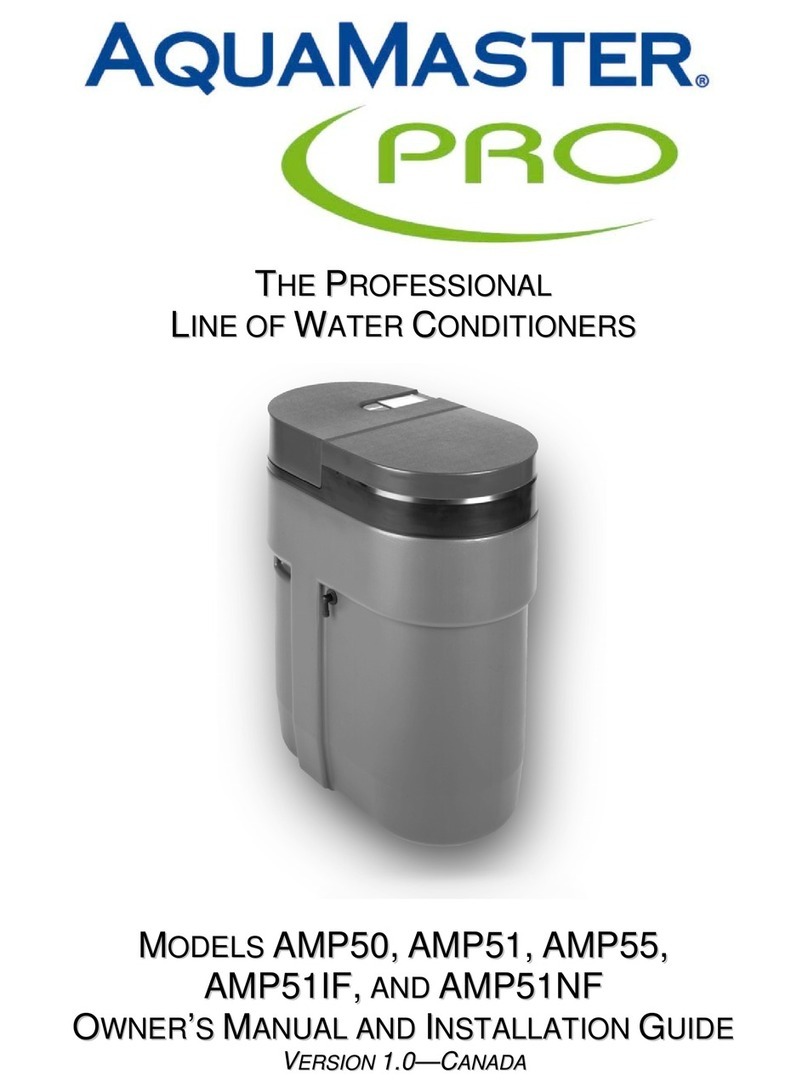
AquaMaster®Pro Owner’s Manual 1/21/2021 2
10 Year Limited Warranty
To Whom Warranty Is Extended
This warranty is issued to the original owner at the original
location site and is not transferable to other sites or to
subsequent owners of the system.
TO PLACE THE EQUIPMENT UNDER WARRANTY, THE
WARRANTY REGISTRATION CARD MUST BE COMPLETED
AND RETURNED BY THE ORIGINAL OWNER TO
AquaMaster®WITHIN 30 DAYS OF INSTALLATION.
Coverage
This limited warranty covers the AquaMaster®system delivered
to the original owner at the original location when the system is
purchased for personal, family, or household use. It is intended
to cover defects occurring in workmanship or materials or both.
Warrantor’s Performance and Length of Limited Warranty
AquaMaster®warrants that upon receipt from the original owner
of any mechanical or electronic part which is found to be
defective in materials or workmanship, AquaMaster®will repair
or replace the defective item for 3 years from date of original
installation. Media is not warranted.
AquaMaster®further warrants that upon receipt from the
original owner of any AquaMaster®media tank/valve body,
brine cabinet, found to be defective in material or workmanship,
AquaMaster®will repair or replace the defective item for
10 years from date of original installation.
All defective parts must be returned, along with the equipment
serial number and date of original installation, to AquaMaster®
PREPAID, and replacement parts will be returned by
AquaMaster®to the original owner FREIGHT COLLECT.
Further Exclusions and Limitations on Warranty
THERE ARE NO WARRANTIES OTHER THAN THOSE
DESCRIBED IN THIS WARRANTY INSTRUMENT.
This warranty does not cover any service call or labor costs
incurred with respect to the removal and replacement of any
defective part or parts. AquaMaster®will not be liable for, nor
will it pay service call or labor charges incurred or expended
with respect to this warranty.
In the event the water supply being processed through this
product contains sand, bacterial iron, algae, sulphur, tannins,
organic matter, or other unusual substances, then, unless the
system is represented as being capable of handling these
substances in the system specifications, other special treatment
of the water supply must be used to remove these substances
before they enter this product. Otherwise, AquaMaster®shall
have no obligations under this warranty.
This warranty does not cover damage to a part or parts of the
system from causes such as fire, accidents, freezing, or
unreasonable use, abuse, or neglect by the owner.
This warranty does not cover damage to a part or parts of the
system resulting from improper installation. All plumbing and
electrical connections should be made in accordance with all
local codes and the installation instructions provided with the
system. The warranty does not cover damage resulting from use
with inadequate or defective plumbing; inadequate or defective
water supply or pressure; inadequate or defective house wiring;
improper voltage, electrical service, or electrical connections; or
violation of applicable building, plumbing, or electrical codes,
laws, ordinances, or regulations.
THIS WARRANTY DOES NOT COVER INCIDENTAL,
CONSEQUENTIAL, OR SECONDARY DAMAGES.
ANY IMPLIED WARRANTIES ON THE PRODUCT
DESCRIBED IN THIS WARRANTY WILL NOT BE EFFECTIVE
AFTER THE EXPIRATION OF THIS WARRANTY.
No dealer, agent, representative or other person is authorized to
extend or expand this limited warranty.
Claims Procedures
Any defects covered by this warranty should be promptly
reported to:
AquaMaster®
4343 South Hamilton Road
Groveport, Ohio 43125, USA
When writing about the defects, please provide the original
owner’s name, telephone number, and original address, serial
number and model number of the product, and date of
purchase. (This information should be listed in General
Information at the front of this manual.) AquaMaster®reserves
the right to replace defective parts with exact duplicates or their
equivalent.
Call the HelpLine, 1-800-437-8993, for Return Information
from 8 a.m. to 5 p.m. EST. The HelpLine fax number is
(614) 836-9876.




























